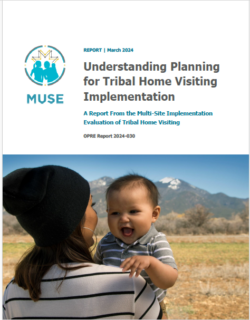Understanding Planning for Tribal Home Visiting Implementation: A Report From the Multi-Site Implementation Evaluation of Tribal Home Visiting
- Authors:
- Melina Salvador
- Kirsten Keene
- Tess Abrahamson-Richards
- William Voinot-Baron
- Patrice Cachat
- Kate Lyon
- Nancy Whitesell
The U.S. Department of Health and Human Services reviews early childhood home visiting models to assess their evidence of effectiveness. Most of the models examined, however, have not been created for or tested with Indigenous communities.
 As part of the first-multi-site, multi-model evaluation of home visiting in tribal communities, the study team partners with Tribal Maternal, Infant, and Early Childhood Home Visiting (MIECHV) grantees to help build the evidence base for home visiting in Indigenous contexts. This report describes how Tribal MIECHV programs were planned and what influenced the planning process. It also offers general findings and recommendations for using evidence-based policy meaningfully and ethically in Indigenous communities:
As part of the first-multi-site, multi-model evaluation of home visiting in tribal communities, the study team partners with Tribal Maternal, Infant, and Early Childhood Home Visiting (MIECHV) grantees to help build the evidence base for home visiting in Indigenous contexts. This report describes how Tribal MIECHV programs were planned and what influenced the planning process. It also offers general findings and recommendations for using evidence-based policy meaningfully and ethically in Indigenous communities:
- Tribal MIECHV programs planned to use equity-focused Indigenous practices to support child and community well-being through home visiting.
- Programs built on Implementation Plan Guidance and model guidance to plan their home visiting programs.
- Additional and augmented implementation approaches and concepts may be required to adequately support evidence-based program implementation in Native communities.
The authors present further refined findings by chapter, as well as detailed recommendations related to Tribal MIECHV implementation support; implementation research; and home visiting research, practice, and policymaking.

